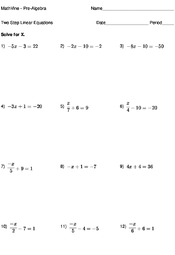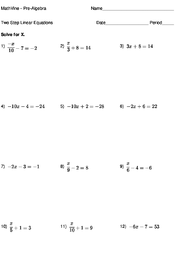Two Step Linear Equations
Introduction
Linear equations are equations that represent a line on a graph in the xy plane. The standard way of writing these equations is using the template y=mx+b (known as the slope-intercept format). m is the slope of the line (it tells us how steeply the line rises or falls) and b is the point at which the line crosses the y-axis (also where the x value is 0).
In order to 'solve'a linear equation, you need to get all of the like terms on the same side of the equation, with the y value on the left on its own, and the x value on the right with the number (representing the b value). Two-step equations are like a one-step equation, although you have two sets of variables to organize.
Terms
Lesson
Two-step linear equations are when there are two of the variables that need to be solved in order to put the equation into its slope-intercept form of y=mx+b.
For example:
In order to solve this equation, we need to get all of the like terms together, with the y value on the left, and the x value and the number on the right.
First, we would subtract 2y from both sides. This will remove the 2y from the right-hand side of the equation, but since we're doing it to both sides, it won't upset the balance of the equation.
Then, we need to move the -7 to the opposite side of the equation. To cancel it out without unbalancing the equation, we can add 7 to both sides:
Since we have y = on one side of the equation and an x value and a number on the other, the equation is now solved.


